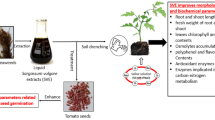Abstract
One of the most important physiological manifestations of abiotic stress in plants is rapid burst of reactive oxygen species (ROS), which severely damages cell structure and function. In the present study, oxidative stress was induced in field grown maize by application of methyl viologen at the flowering stage. 48 h prior to the induced stress, a set of plants were treated with graded concentrations (0.5, 1.0 and 1.5 mM) of ascorbic acid (AsA). Data for hyper-spectral reflectance and chlorophyll content was recorded post treatment and post stress, while root biomass and grain yield was recorded at harvest. Membrane leakage, total soluble proteins, and specific activities of three key ROS scavenging enzymes viz., superoxide dismutase (SOD), catalase (CAT), and peroxidases (POX) were also determined. AsA treatment led to increase in chlorophyll content, root biomass and grain yield and reduced electrolyte leakage under stress. Biochemical analysis revealed widespread rebalancing of ROS scavenging enzymes after stress and AsA treatment. In control plants, SOD activity decreased upon induction of stress, while in AsA treated plants SOD activity increased significantly. Similarly, AsA application caused remarkable increase in CAT activity, while it did not significantly affect POX activity under stress. The study concludes that AsA is capable of alleviating oxidative stress in maize through increasing activity of antioxidant enzymes like SOD and CAT.




Similar content being viewed by others
References
Aebi, H. (1983). Catalase. In H. Bergmeyer (Ed.), Methods of enzymatic analysis. Weinheim, Germany: Verlag Chemical.
Apel, K., & Hirt, H. (2004). Reactive oxygen species: Metabolism, oxidative stress, and signal transduction. Annual Review of Plant Biology, 55, 373–399.
Bradford, M. M. (1976). Rapid and sensitive method for the quantitation of microgram quantities of protein utilizing the principle of protein-dye binding. Analytical Biochemistry, 72, 248–254.
Chen, Z., Young, T. E., Ling, J., Chang, S. C., & Gallie, D. R. (2003). Increasing vitamin C content of plants through enhanced ascorbate recycling. Proceedings of the National Academy of Sciences of the United States of America, 100, 3525–3530.
Dolatabadian, A., & Jouneghan, R. S. (2009). Impact of exogenous ascorbic acid on antioxidant activity and some physiological traits of common bean subjected to salinity stress. Notulae Botanicae Horti Agrobotanici Cluj, 37, 165–172.
Dolatabadian, A., Sanavi, A. M., & Sharifi, M. (2009). Alleviation of water deficit stress effects by foliar application of ascorbic acid on Zea mays L. Journal of Agronomy and Crop Science, 195, 347–355.
Giacomelli, L., Rudella, A., & van Wijk, K. J. (2006). High light response of the thylakoid proteome in Arabidopsis wild type and the ascorbate-deficient mutant vtc2-2. A comparative proteomics study. Plant Physiology, 141, 685–701.
Gill, S. S., & Tuteja, N. (2010). Reactive oxygen species and antioxidant machinery in abiotic stress tolerance in crop plants. Plant Physiology and Biochemistry, 48, 909–930.
Kakkar, P., Dos, B., & Viswnathan, P. N. (1984). A modified spectrophotometric assay of superoxide dismutase. Indian Journal of Biochemistry, 21, 130–132.
Lascano, H. R., Gómez, L. D., Casano, L. M., & Trippi, V. S. (1999). Wheat chloroplastic glutathione reductase activity is regulated by the combined effect of pH, NADPH and GSSG. Plant and Cell Physiology, 40, 683–690.
Li, F., Wu, Q. Y., Sun, Y. L., Wang, L. Y., Yang, X. H., & Meng, Q. W. (2010). Overexpression of chloroplastic monodehydroascorbate reductase enhanced tolerance to temperature and methyl viologen-mediated oxidative stresses. Physiologia Plantarum, 139, 421–434.
Manivannan, P., Jaleel, C. A., Sankar, B., Kishorekumar, A., Somasundaram, R., Alagu-Lakshmanan, G. M., et al. (2007). Growth, biochemical modifications and proline metabolism in Helianthus annuus L. as induced by drought stress. Colloids and Surfaces B: Biointerfaces, 59, 141–149.
Miguel, A., Rosales, J., Ruiz, M., Hernandez, J., Soriano, T., Castilla, N., et al. (2006). Antioxidant content and ascorbate metabolism in cherry tomato exocarp in relation to temperature and solar radiation. Journal of the Science of Food and Agriculture, 86, 1525–1551.
Mittler, R. (2002). Oxidative stress, antioxidants and stress tolerance. Trends in Plant Science, 7, 405–441.
Moaveni, P. (2011). Effect of water deficit stress on some physiological traits of wheat (Triticum aestivum). Agricultural Science Research Journal, 1, 64–68.
Munir, N., & Aftab, F. (2011). Enhancement of salt tolerance in sugarcane by ascorbic acid pretreatment. African Journal of Biotechnology, 10, 18362–18370.
Pattanagul, W. (2011). Exogenous abscisic acid enhances sugar accumulation in rice (Oriza sativa L.) under drought stress. Asian Journal of Plant Science, 10, 212–219.
Reddy, K. P., Subhani, S. M., Khan, P. A., & Kumar, K. B. (1995). Effect of light and benzyl adenine on dark-treated growing rice leaves, II changes in peroxidase activity. Plant and Cell Physiology, 24, 987–994.
Szarka, A., Tomaskovics, B., & Banhegyi, G. (2012). The ascorbate-glutathione-a-tocopherol triad in abiotic stress response. International Journal of Molecular Sciences, 13, 4458–4483.
Wang, Z., Xiao, Y., Chen, W., Tang, K., & Zhang, L. (2010). Increased vitamin C content accompanied by an enhanced recycling pathway confers oxidative stress tolerance in Arabidopsis. Journal of Integrative Plant Biology, 52, 400–409.
Acknowledgments
Financial support from Indian Council of Agricultural Research (ICAR) funded Network Project on Transgenics in Crops (NPTC 3015) is thankfully acknowledged for carrying out this research work.
Author information
Authors and Affiliations
Corresponding author
Rights and permissions
About this article
Cite this article
Yadava, P., Kaur, P. & Singh, I. Exogenous application of ascorbic acid alleviates oxidative stress in maize. Ind J Plant Physiol. 18, 339–343 (2013). https://doi.org/10.1007/s40502-014-0057-z
Received:
Accepted:
Published:
Issue Date:
DOI: https://doi.org/10.1007/s40502-014-0057-z




